A Recipe for Diversion
Keys to successful implementation of municipal food waste collection.
February 15, 2012
Rhodes Yepsen, Novamont North America
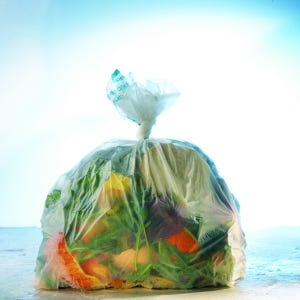 Recycling is perhaps the most discussed facet of municipal solid waste (MSW), from the trucks and carts used to collect recyclables, to single-stream vs. dual stream, often looking at the economics and logistics of managing a program. While opinions on the best way to set up a recycling program are far from unanimous, communities are by and large looking at how to increase recycling rates. According to the U.S. Environmental Protection Agency (EPA), only 34 percent of the total MSW generated in 2010 was recycled, so we clearly have room to improve.
Recycling is perhaps the most discussed facet of municipal solid waste (MSW), from the trucks and carts used to collect recyclables, to single-stream vs. dual stream, often looking at the economics and logistics of managing a program. While opinions on the best way to set up a recycling program are far from unanimous, communities are by and large looking at how to increase recycling rates. According to the U.S. Environmental Protection Agency (EPA), only 34 percent of the total MSW generated in 2010 was recycled, so we clearly have room to improve.
The emerging task, therefore, is to determine next steps to capture more of these wastes and turn them into resources to be recycled. EPA estimates that more than 62 percent of the MSW generated each year is organic: yard trimmings, food waste, wood and paper/paperboard. While 57.5 percent of yard trimmings are captured for composting and mulch, less than 3 percent of food waste is captured. It’s no wonder that municipal food waste collection programs are being planned and implemented across the United States.
Locally Sourced
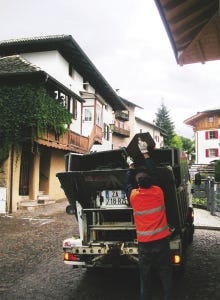 According to a 2011 survey conducted by BioCycle magazine, there are over 150 U.S. communities with residential food waste collection, which represents a roughly 70-percent increase over the number of communities collecting food waste in 2009. These food waste programs reach more than 2.3 million households, in 16 different states. For some areas, high landfill tip fees are the biggest driver in the development of food waste programs, with communities realizing significant savings following implementation. These savings can be passed down to residents, for example, in the form of pay-as-you-throw (PAYT) fee structures, with smaller fees for reducing trash can size. Other areas are prompted to start food waste collection programs by legislation, such as California establishing a state-wide diversion goal of 75 percent by 2020. This challenging feat will require food waste collection.
According to a 2011 survey conducted by BioCycle magazine, there are over 150 U.S. communities with residential food waste collection, which represents a roughly 70-percent increase over the number of communities collecting food waste in 2009. These food waste programs reach more than 2.3 million households, in 16 different states. For some areas, high landfill tip fees are the biggest driver in the development of food waste programs, with communities realizing significant savings following implementation. These savings can be passed down to residents, for example, in the form of pay-as-you-throw (PAYT) fee structures, with smaller fees for reducing trash can size. Other areas are prompted to start food waste collection programs by legislation, such as California establishing a state-wide diversion goal of 75 percent by 2020. This challenging feat will require food waste collection.
The majority of these 150 communities initiated food waste collection by first making basic modifications to existing yard trimmings collection programs, allowing residents to begin adding food waste to their yard trimmings cart. This material is then co-collected in a single truck and taken to a composting facility. Residents are commonly given kitchen pails for collecting food scraps, and brochures detailing what is permitted in the green cart. Most programs accept all food wastes (including meat, dairy and food-soiled paper), although some limit feedstocks to fruits and vegetables, often due to permit restrictions. Garbage and organics typically are collected weekly, while recycling is collected either weekly or biweekly.
Setting the Table
These pioneer communities are often faced with the same problem facing conventional recycling programs: how to increase participation and boost diversion rates. Increasingly, programs are promoting compostable bags approved by the Biodegradable Products Institute (BPI), which ease participation by keeping kitchen pails clean and hygienic, and reducing the “ick factor” of managing food scraps. As mentioned above, some communities employ PAYT or variable fee structures.
A few communities, like Portland, Ore., Hutchinson, Minn., and Olympia, Wash., are employing a more aggressive method, reducing standard trash collection frequency to biweekly. Portland allows residents to opt for monthly trash collection, or even on-call pickup. Another approach involves mandated participation in composting and recycling programs, which San Francisco and Seattle have had in place for a few years (Seattle allows residents to opt out of green cart service if they submit letters indicating they practice backyard composting).
Pioneers in Putrescible Waste
The development of residential food waste programs in the United States in many ways mirrors what happened in Europe a decade ago, and there are some lessons that can be drawn from their experiences. In the United Kingdom, for instance, many communities starting food waste programs also had existing curbside yard trimmings carts, to which food waste was then added. However, studies from the Waste & Resources Action Programme (WRAP) concluded that separate collection of curbside food waste is more financially and environmentally viable for the United Kingdom. One report, “Evaluation of the WRAP Separate Food Waste Collection Trials,” was based on trials in 21 local authorities from 2007 to 2009, and noted that separate collection of food waste could increase the capture rate of food, and helped keep processing costs for food waste to a minimum. Households in the trial were given certified compostable bags, and capture rates were typically 50 percent higher than households co-collecting food waste with yard trimmings.
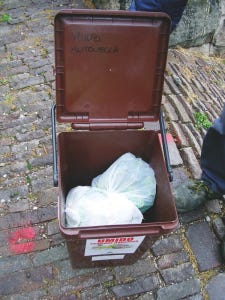 Separate food scraps collection schemes in the United Kingdom and in other countries like Spain are based, in part, on the successes of northern Italy’s food waste collection programs developed in the mid-1990s. Referred to as “intensive source-separated organics” (ISSO), the system was established in response to dwindling landfill capacity and increasing tipping fees in northern Italy, which forced municipalities to maximize organics diversion. ISSO reduces the amount of putrescible materials in residual waste to less than 10 percent, thereby allowing trash collection frequency to be reduced, making the scheme economically viable.
Separate food scraps collection schemes in the United Kingdom and in other countries like Spain are based, in part, on the successes of northern Italy’s food waste collection programs developed in the mid-1990s. Referred to as “intensive source-separated organics” (ISSO), the system was established in response to dwindling landfill capacity and increasing tipping fees in northern Italy, which forced municipalities to maximize organics diversion. ISSO reduces the amount of putrescible materials in residual waste to less than 10 percent, thereby allowing trash collection frequency to be reduced, making the scheme economically viable.
In other words, ISSO sets out best practices for implementing a municipal food waste program, including the tools needed, frequency of collection, communication scheme, etc. With ISSO, recyclables are collected weekly, trash biweekly, and food waste between one and three times per week (depending on climate). Food waste is collected separately from yard trimmings in small curbside carts; eight to 10 gallons for single-family households, and 64- or 95-gallon carts for condos.
Smaller and quicker gas-powered collection vehicles, without compaction, are used to collect the bagged food scraps (compaction is not required because the material is wet and dense). Seasonal collection of yard trimmings is offered, but backyard composting is heavily encouraged (the logic being that if you have a yard large enough to produce a lot of clippings, you have enough space to compost).
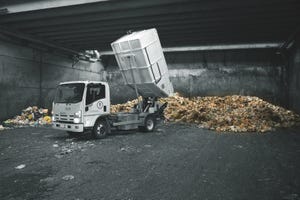 In a significant number of municipalities, residents also are supplied with appropriate household tools, namely a two-gallon kitchen pail and yearly supplies of breathable Mater-Bi compostable bags (certified according to EN 13432 and ASTM D6400). As in the United States, while solid pails were originally used in Europe, they are being replaced with vented pails (open areas on the side walls and lid). Certain grades of compostable Mater-Bi resin have very high water vapor transmission rates that enable wet food waste to transpire, or dry out, when used with a vented pail. This drying process yields a weight and volume reduction, resulting in less waste to be collected and treated. It also reduces microbial activity, meaning fewer unpleasant odors and a more hygienic bin.
In a significant number of municipalities, residents also are supplied with appropriate household tools, namely a two-gallon kitchen pail and yearly supplies of breathable Mater-Bi compostable bags (certified according to EN 13432 and ASTM D6400). As in the United States, while solid pails were originally used in Europe, they are being replaced with vented pails (open areas on the side walls and lid). Certain grades of compostable Mater-Bi resin have very high water vapor transmission rates that enable wet food waste to transpire, or dry out, when used with a vented pail. This drying process yields a weight and volume reduction, resulting in less waste to be collected and treated. It also reduces microbial activity, meaning fewer unpleasant odors and a more hygienic bin.
Splitting the Check
Financial viability is one of the main concerns when setting up a municipal food waste collection program. Because hauling is arguably the largest cost in MSW management, it’s worth focusing on how the economics of ISSO in Europe work. Remember, ISSO was devised to maximize the diversion of food and other putrescible wastes. By doing so, trash collection can be reduced to biweekly pickups without a nuisance (and is actually key to getting residents to place putrescible materials in the organics cart).
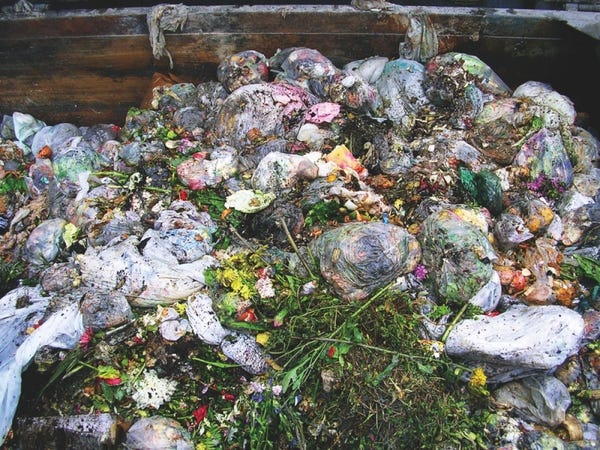 A survey of the economics of collection in Lombardy, a region in northern Italy, was completed in March 2010 and shows that the ISSO model is financially viable. Milan is the capital of Lombardy, and the region contains one-sixth of Italy’s population, almost 10 million people. The survey was based on detailed economic data reported by all 1,546 municipalities in the region (including Milan).
A survey of the economics of collection in Lombardy, a region in northern Italy, was completed in March 2010 and shows that the ISSO model is financially viable. Milan is the capital of Lombardy, and the region contains one-sixth of Italy’s population, almost 10 million people. The survey was based on detailed economic data reported by all 1,546 municipalities in the region (including Milan).
According to the survey, municipalities with ISSO that achieved a diversion rate of 60 percent or greater bore the same average costs as those diverting less than 40 percent. Overall collection and treatment costs decrease with higher diversion rates. Collection costs tend to increase slightly (especially with more than 60-percent diversion), but not as much as was commonly thought before the study. Moreover, those costs are counterbalanced by the decrease in disposal costs.
Municipalities in the United States are beginning to see the advantages of ISSO, adopting aspects like biweekly trash collection in cities like Portland and Olympia, and separate food waste collection in Hennepin County, Minn. As with most recycling initiatives, food waste collection practices in the United States are continually being modified and improved, with the goal of increasing diversion from disposal. As the cost of disposal increases, and people become more aware of the benefits of composting, we will see wider adoption of municipal food waste programs as part of the standard public works offering, along with recycling and trash collection.
Rhodes Yepsen is marketing manager for Novamont North America, Inc., and has conducted extensive research on municipal food waste composting. Contact him at [email protected].
You May Also Like


